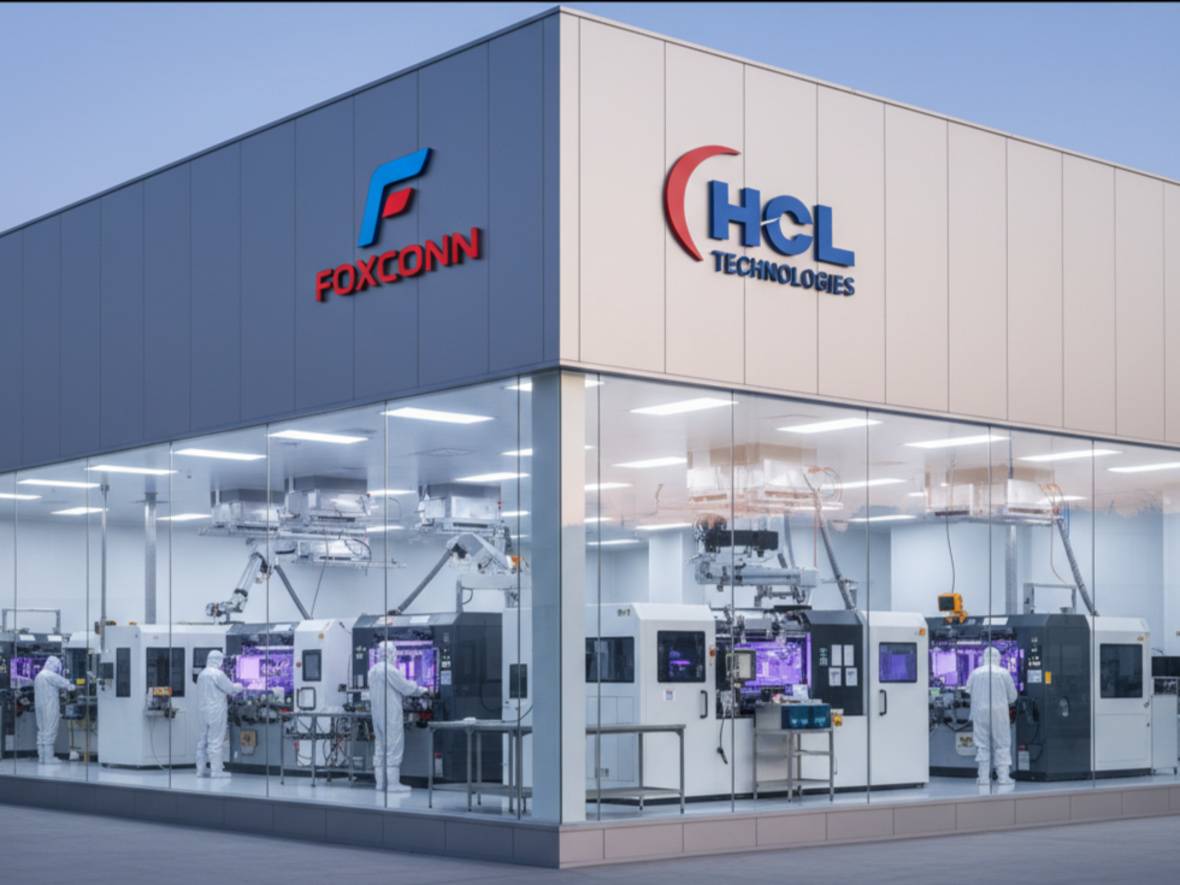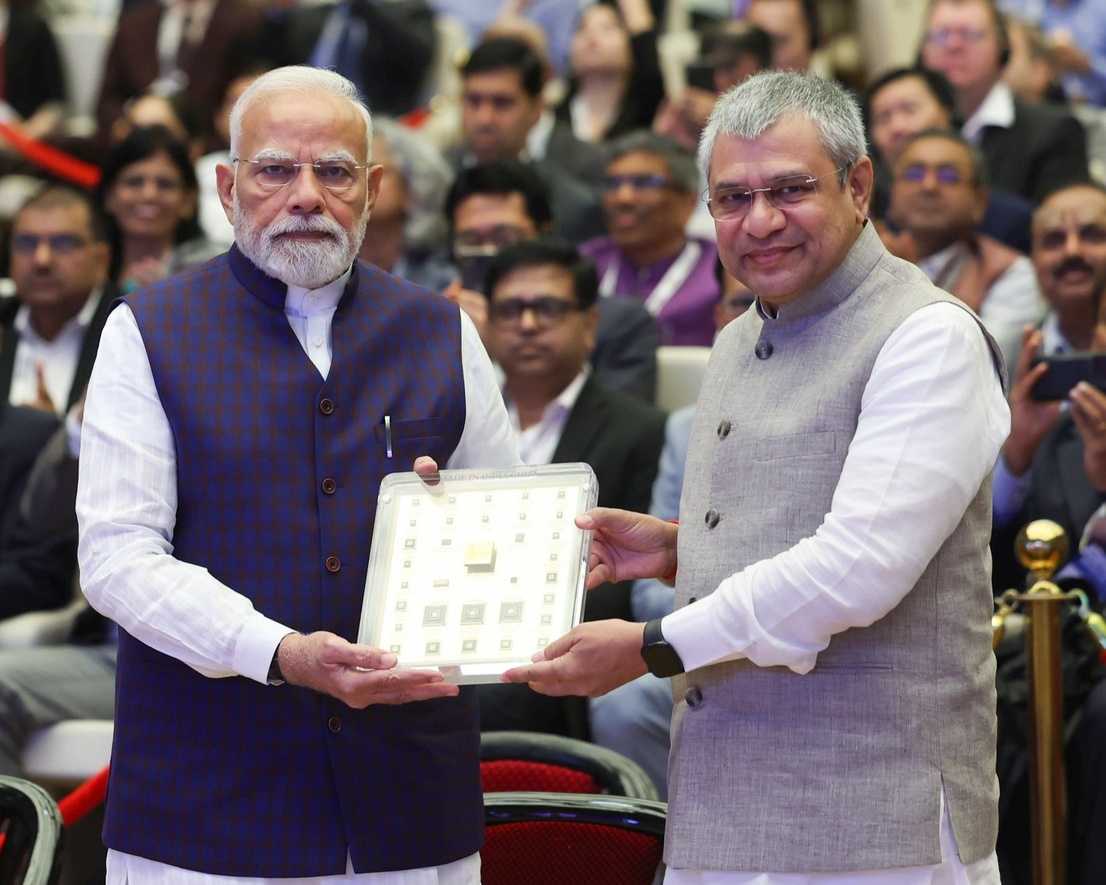“Are IT stocks finished? Is this the end of India’s technology dominance?” These worried questions flooded my inbox last month after another round of hiring freezes hit major IT firms.
As a computer engineer who has been tracking technology trends for over a decade, I understand the concern. Traditional IT services growth has indeed decelerated—TCS reported just 4.1% revenue growth in FY2024, compared to 15%+ in previous years.
But here’s what most observers miss: while headlines focus on layoffs and project cancellations, a major IT sector strategic shift is happening beneath the surface. Indian IT companies’ semiconductor ventures represent a fundamental transformation rather than mere diversification.
HCL, Wipro, and Infosys aren’t just cutting costs—they’re making billion-dollar bets on semiconductors, the technology backbone driving everything from smartphones to electric vehicles. This isn’t just business strategy; it’s industrial evolution driven by India’s semiconductor policy initiatives and global supply chain realignments.
From Code to Chips: Why IT Giants Are Pivoting
![]()
During my engineering career, I’ve observed how technology cycles evolve. The current shift mirrors the transformation from mainframe computing to client-server architecture in the 1990s—companies that adapted thrived, while others became irrelevant.
The data reveals why IT services revenue diversification has become critical:
- Indian IT services growth: 3.8% (FY2024) vs. 15.2% (FY2019)
- Global semiconductor market: Expected to reach ~$700 billion by 2025, following $627 billion in 2024 sales with 18.9% YoY growth in H1 2025
- Indian semiconductor market growth: Projected at 19% CAGR through 2026
Traditional IT services face structural challenges I’ve witnessed across the industry. Automation eliminates routine coding jobs, clients demand outcome-based pricing, and geopolitical tensions reshape global delivery models. Companies focused solely on traditional services risk commoditization.
India’s semiconductor policy framework creates unprecedented opportunities. The Production Linked Incentive (PLI) scheme offers up to 50% financial incentives for chip manufacturing investments. More importantly, it addresses the critical shortage of semiconductor professionals—a gap I’ve observed through interactions with engineering institutions.
The competitive advantage lies in existing relationships. These IT giants already serve Intel, AMD, NVIDIA, and other chip manufacturers with software services. They understand client requirements, have established trust, and possess engineering talent for hardware domain expansion.
This transformation addresses long-term sustainability concerns while capital allocation efficiency compares favorably to traditional IT expansion, which faces margin pressures and commoditization risks.
HCL & Foxconn’s $435M Fab: India’s Chip Future

India’s Chip Future The HCL Foxconn semiconductor fab announcement initially seemed ambitious, but analyzing the partnership structure reveals serious industrial commitment rather than corporate publicity. The scale is unprecedented for Indian technology infrastructure in the OSAT (Outsourced Semiconductor Assembly and Test) segment:
- Total investment: $435 million (₹3,706 crores) over initial phases
- Expected capacity: 36 million chips per month by 2027 (focusing on display driver ICs)
- Job creation: ~2,000 direct employment opportunities
- Revenue potential: ₹5,000+ crores annually at full capacity (based on similar OSAT benchmarks)
Uttar Pradesh semiconductor manufacturing benefits from strategic advantages—proximity to Delhi-NCR’s talent hub, the upcoming Noida International Airport, and state government support. The location matches global standards for semiconductor assembly and testing requirements.
This represents potential business model transformation. Current IT services contribute 85% of HCL’s revenues. Analysts project semiconductor manufacturing could contribute up to 20-25% of revenues by 2030 with superior margins, assuming successful execution.
This represents potential business model transformation. Current IT services contribute 85% of HCL’s revenues. Semiconductor manufacturing could contribute 25% of revenues by 2030 with superior margins.
Wipro’s Automotive Chip Gamble with Harman
![]()
The Wipro acquisition of Harman’s DTS unit in August 2025 for $375 million demonstrates how traditional IT companies can leverage domain expertise for semiconductor expansion. Having tracked Wipro’s automotive vertical development, their systematic capability building now positions them uniquely in the semiconductor value chain. Harman International (a Samsung subsidiary) dominates automotive semiconductor solutions with ~65% market share in premium car audio systems and growing presence in autonomous driving technologies.
Wipro’s acquisition provides:
- Technology access to automotive chip design capabilities, including connected car and infotainment R&D
- Client relationships with BMW and Mercedes-Benz (expanding to other OEMs) · R&D collaboration on next-generation automotive electronics
- Manufacturing partnerships for localized production
The automotive semiconductor India market opportunity is substantial. India’s automotive electronics market is projected to reach ~$15 billion by 2026, en route to $19 billion by 2030, driven by electric vehicle adoption and connected car technologies.
Industry interactions reveal consistent challenges around semiconductor supply chain reliability. Wipro’s Harman partnership addresses this through:
- Localizing chip design for Indian automotive requirements
- Reducing import dependency on critical automotive semiconductors
- Creating integrated solutions combining software and hardware
- Enabling faster time-to-market for Indian automotive OEMs
Global automotive semiconductors represent a $72 billion market in 2024, growing at 7-10% CAGR to $123 billion by 2032.
Connected vehicle and IoT opportunities add another dimension. With 5G rollout accelerating, demand for automotive connectivity solutions will expand significantly. Wipro’s existing telecom domain expertise combined with Harman’s hardware capabilities creates comprehensive value propositions.
Analysts estimate this acquisition could contribute 12-18% of Wipro’s revenues by 2028, with margins potentially exceeding traditional IT services by 3-4 percentage points, building on the auto vertical’s current ~10% share.
Infosys Goes In-House with InSemi Deal

The Infosys InSemi acquisition represents the most strategic semiconductor move among Indian IT giants. Having followed Infosys’s engineering services evolution, this fits their systematic approach to building next-generation capabilities.
InSemi brings proven chip design expertise across:
- Analog and mixed-signal circuits for automotive applications
- Power management ICs for mobile and IoT devices
- RF/wireless communication chips for 5G infrastructure
- AI/ML accelerator design for edge computing
The semiconductor design services India market is positioned for significant growth. Global chip design services represent a $45 billion opportunity, with India currently capturing just 8% market share despite having 25% of global semiconductor talent.
Infosys’s strategic rationale becomes clear when examining their existing engineering services portfolio. They already provide R&D services to semiconductor companies like Intel, AMD, and Qualcomm. InSemi acquisition creates vertical integration—from chip design to software development to system integration.
Client synergies are immediate:
- Existing automotive clients require custom semiconductor solutions
- Telecom infrastructure projects need specialized chip design
- Industrial IoT implementations demand edge computing capabilities
- Healthcare technology ventures require power-efficient processing solutions
The talent acquisition aspect is crucial. InSemi’s 200+ semiconductor engineers provide Infosys immediate domain expertise that would take 3-4 years to build organically.
Revenue contribution timeline projections (based on engineering services growth trends):
- Year 1-2: Integration and capability building (₹200-300 crores revenue)
- Year 3-4: Client expansion and new service offerings (₹800+ crores revenue)
- Year 5+: Potential leadership position in design services (₹1,500+ crores revenue
assuming 20-25% CAGR in the segment
Competitive positioning improves significantly. Against global chip design firms like Cadence and Synopsys, Infosys offers cost advantages and integrated service delivery that pure-play design companies cannot match.
India’s First Made-in-India Chip: Vikram Marks a Historic Milestone

In a landmark moment for India’s semiconductor ambitions, Prime Minister Narendra Modi received the country’s first indigenous semiconductor chip—the Vikram 32-bit processor—at the inauguration of Semicon India 2025 in New Delhi on September 2. Developed by ISRO’s Semiconductor Laboratory, this RISC-V-based chip represents a breakthrough in domestic design and fabrication, with Union IT Minister Ashwini Vaishnaw presenting it alongside test chips from four ISM-approved projects.
This isn’t just symbolic; it’s a tangible step forward under the India Semiconductor Mission. The Vikram chip, optimized for space and defense applications, was fabricated using 180nm CMOS technology and highlights India’s growing prowess in custom silicon. With five key production units now operational and on track, the first commercial chips from facilities like Tata’s Dholera fab (India’s inaugural full-scale semiconductor plant) are slated for rollout by late 2025 or early 2026. The event also underscored ecosystem momentum: AMD announced a $400 million investment in Indian design centers, while Merck projected India’s local semi market hitting $100 billion by 2030.
From my vantage as a tech analyst, this launch validates the PLI incentives’ impact—up to 50% fiscal support that’s already drawn $15+ billion in commitments across six approved plants. It complements the IT giants’ strategies: HCL’s OSAT partnerships could handle Vikram-like assembly, Wipro’s automotive focus aligns with expanding chip apps in EVs, and Infosys’s design expertise feeds into ISRO-style R&D. Challenges remain, like scaling to sub-65nm nodes, but Vikram signals India’s shift from importer to innovator, potentially accelerating the 19% CAGR in our domestic market through 2026.
For investors, watch for supply chain ripple effects—local chips could boost IT firms’ margins by reducing import reliance by 20-30% in embedded systems.
Tracking India’s Semiconductor Revolution

Analyzing IT stocks semi-conductor exposure reveals important considerations for anyone tracking this industry transformation:
Valuation Impact Potential:
Current IT stock valuations reflect traditional services multiples (18-20x P/E as of mid-2025). Semi-conductor exposure could potentially drive re-rating to 22-25x, similar to global technology companies with hardware components, per analyst models.
Timeline for Material Revenue Contribution:
- 2025: Pilot revenues and proof-of-concept completion
- 2026-27: 3-6% of total revenues from semiconductor ventures
- 2028-30: 10-20% revenue contribution with potentially superior margins
Risk Factors to consider:
- Capital Intensity: Semi-conductor ventures require sustained investment over 5-7 years before meaningful returns
- Technology Obsolescence: Rapid technology evolution could make current investments redundant
- Geopolitical Tensions: US-China semi-conductor restrictions could impact technology access
- Execution Risk: Complex manufacturing and design capabilities require different skill sets
Comparison with Pure-Play Semiconductor Companies:
Indian IT giants offer diversified exposure—if semi-conductor bets don’t succeed, traditional services provide stability. Pure-play semi-conductor stocks like LTTS or Tata Elxsi carry higher risk-reward profiles.
Key Monitoring Metrics for industry observers:
- Quarterly semi-conductor revenue disclosure
- R&D spending as percentage of revenues
- New client acquisitions in semi-conductor vertical
- Talent hiring in chip design and manufacturing
- Partnership announcements with global semi-conductor companies
Indian semi-conductor investment opportunities extend beyond IT stocks to include semi-conductor ETFs, equipment manufacturers, and specialized design companies for comprehensive sector exposure.
What This Means for India’s Tech Future
![]()
The Indian tech giant’s semi-conductor strategy represents more than corporate diversification—it’s potential national economic transformation. Having witnessed India’s IT services evolution, I see striking parallels with the current semi-conductor pivot.
Just as Y2K created the foundation for India’s software services dominance, global supply chain disruptions and geopolitical tensions are creating unprecedented opportunities in semi-conductor manufacturing and design.
Timeline expectations for meaningful business impact:
- 2025: Foundation building and pilot production
- 2026-27: Revenue contribution becomes visible in quarterly results
- 2028-30: Semiconductor ventures potentially drive significant valuation changes
The broader implications for the Indian technology ecosystem could be transformational. Success in semi-conductors might position India as a global technology hub beyond services, potentially creating millions of high-skilled jobs and reducing import dependency on critical technologies.
Key considerations for industry observers:
- Track progress closely: Monitor quarterly updates on semiconductor ventures
- Understand different approaches: Each company has distinct semiconductor strategies
- Consider timeline reality: This transformation requires 3-5 years for material impact
- Evaluate execution capability: Manufacturing and design require different competencies than services
- Watch for partnerships: Strategic alliances often indicate serious commitment
Why Semiconductors Could Define India’s Tech Future

India’s top IT companies are no longer just service providers — they’re on the frontlines of a historic shift from software to semiconductors. With billion-dollar investments, strategic acquisitions, and global partnerships, giants like HCL, Wipro, and Infosys are positioning themselves for the next era of technological leadership.
This transformation won’t happen overnight. It will take years of execution, talent development, and navigating geopolitical challenges. But if these bets succeed, India could emerge as a global semiconductor powerhouse, reducing its dependency on imports and creating millions of high-skilled jobs.
For investors and industry watchers, this is a rare opportunity to witness an inflection point — one that could redefine India’s place in the global tech ecosystem for decades to come.
For more data-driven analysis of emerging technology trends, visit PaisaForever.com where I break down complex tech and finance topics for Indian readers.
Also read : Automate Profits: AI Trading Bots for Stocks & Crypto
Disclaimer: This article is for informational and educational purposes only. It should not be considered financial or investment advice. Readers are encouraged to conduct their own research or consult a qualified professional before making any investment decisions. The author and website are not responsible for any losses arising from the use of the information provided.


